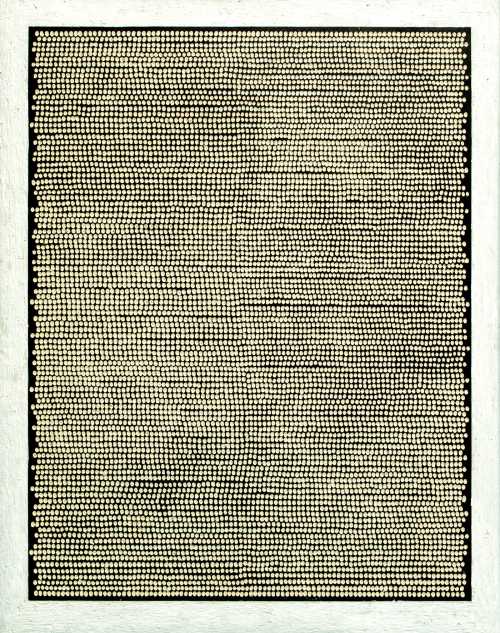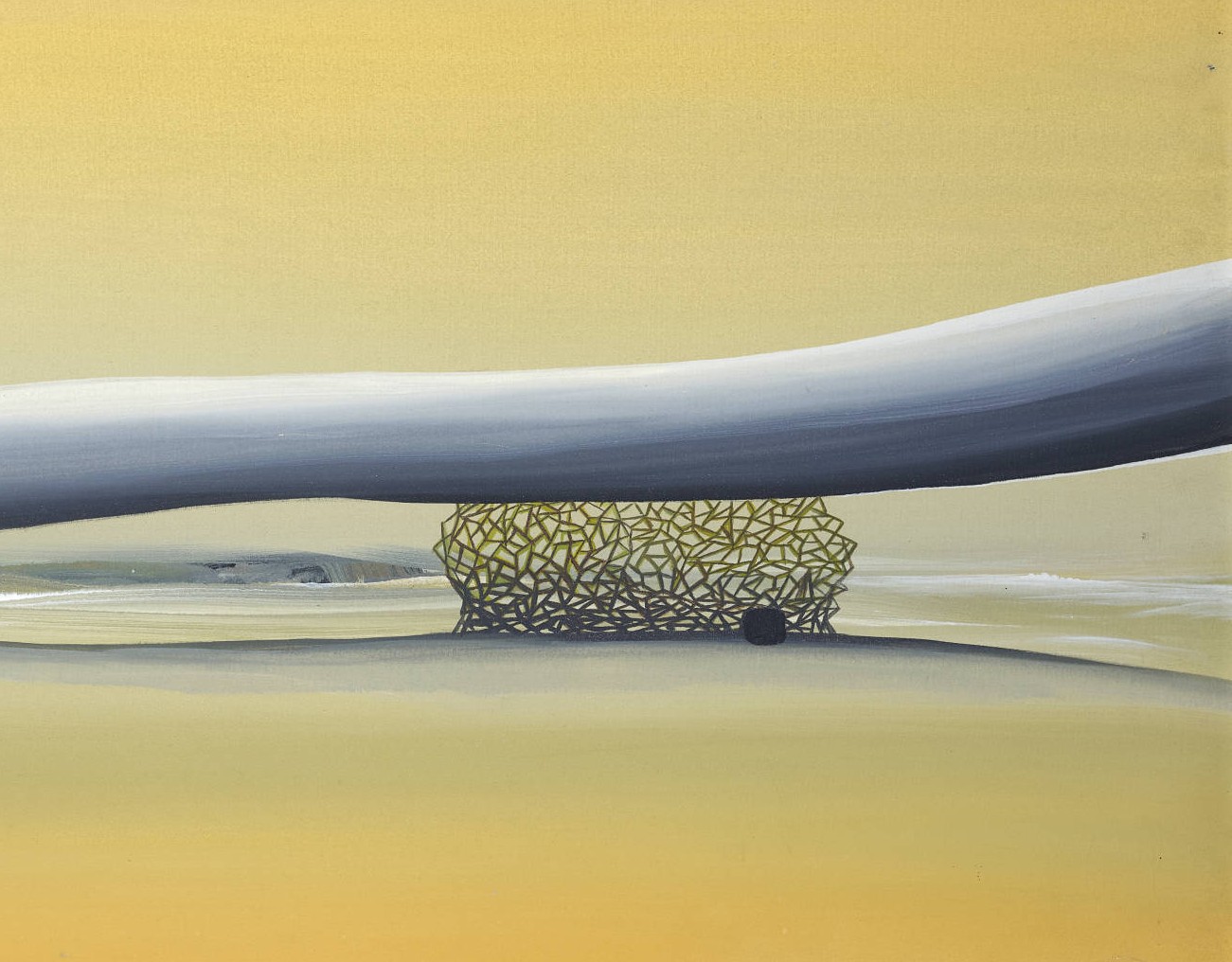About Farshid Maleki
Farshid Maleki is one of the second generation of modernist Iranian painters. Maleki's personal style in drawing and painting has made it impossible for him to belong to a particular current of modern Iranian art. A trait that has been the result of the painter's conscious efforts to achieve a distinctive approach: “My work is unlike any other among Iranian artists. They are absolutely mine."
He was interested in painting as a child and began his art education at Kamal al-Molk Conservatory. After graduating with a bachelor's degree in graphics from the Faculty of Decorative Arts at Tehran University of Arts in 1969, and participating in a 3-month study opportunity provided by the Television Organization to get acquainted with British television, he remained in London and continued his art studies. Simultaneously with the Islamic Revolution, he completed his postgraduate studies in painting at the University of Reading in the United Kingdom and returned to Iran. Maleki has teaching experience at Farabi University, Al-Zahra University and Islamic Azad University and has been a member of the faculty of Tehran University of Arts. He has collaborated with Iranian galleries such as Golestan, Aria, Hoor, Emkan and Azad Designers and has exhibited his works many times outside of Iran.
Maleki joined the Iran Hall by the invitation of Ruyin Pakbaz and held his first solo exhibition in 1968 in the same hall. His second solo exhibition was held in 1973 at Ghandriz Hall. In an article for the Cosmos Art page, Alkhaz compared his work to African totems. In next periods, Maleki abandoned the totems and distanced himself from the currents of national art identity and "neo-traditionalism" which resulted in his works to lack the traditional features that his contemporaries borrowed from the Iranian artistic tradition. "After a while, I thought, what does it mean for us to try to be Iranian?" If we are Iranians, then our work is also Iranian. "There is no need to force anymore." said Maleki about his work.
He pursued a personal language in the direction of designs that began in the mid-1990s. In these contour drawings, drawn with a rapidograph, with free and deliberately delineated lines, he expands the forms in the direction of the mental fluid flow, creating a world full of deformed people, strange animals and plants, celestial bodies, spheres, wheels, and other objects. In his speeches, Maleki expresses his interest in the works of Max Ernst and confirms the surrealist tendencies of his works in this period, and considers the origin of the narrative nature of these designs to be influenced by Gustave's illustrations of the period.
Iman Afsariyan considers Maleki to be one of the few Iranian painters who dare to change his style several times.
Fereydoun Ghaffari says about the early and late periods of Maleki’s style: "Perhaps it can be said that the final designs of Maleki are more in line with his internal needs without thinking at all about the external needs. There are some who work according to their inner needs, regardless of the current trends of the day, and there are some who are more in tune with their external factors and conditions. "In the case of Maleki, it can be said that his early work is so different from his recent work, or there is a change of attitude."
Farshid Maleki's first appearance in the auctions dates back to December 2016 at the 6th Tehran auction. By August 2021, his works have appeared in domestic and foreign auctions 7 times, and 70% of his works have been sold in international auctions. His most expensive work until 2021 was hammered at the Sotheby's auction house for $ 14085 on May 25, 2016.
He was interested in painting as a child and began his art education at Kamal al-Molk Conservatory. After graduating with a bachelor's degree in graphics from the Faculty of Decorative Arts at Tehran University of Arts in 1969, and participating in a 3-month study opportunity provided by the Television Organization to get acquainted with British television, he remained in London and continued his art studies. Simultaneously with the Islamic Revolution, he completed his postgraduate studies in painting at the University of Reading in the United Kingdom and returned to Iran. Maleki has teaching experience at Farabi University, Al-Zahra University and Islamic Azad University and has been a member of the faculty of Tehran University of Arts. He has collaborated with Iranian galleries such as Golestan, Aria, Hoor, Emkan and Azad Designers and has exhibited his works many times outside of Iran.
Maleki joined the Iran Hall by the invitation of Ruyin Pakbaz and held his first solo exhibition in 1968 in the same hall. His second solo exhibition was held in 1973 at Ghandriz Hall. In an article for the Cosmos Art page, Alkhaz compared his work to African totems. In next periods, Maleki abandoned the totems and distanced himself from the currents of national art identity and "neo-traditionalism" which resulted in his works to lack the traditional features that his contemporaries borrowed from the Iranian artistic tradition. "After a while, I thought, what does it mean for us to try to be Iranian?" If we are Iranians, then our work is also Iranian. "There is no need to force anymore." said Maleki about his work.
He pursued a personal language in the direction of designs that began in the mid-1990s. In these contour drawings, drawn with a rapidograph, with free and deliberately delineated lines, he expands the forms in the direction of the mental fluid flow, creating a world full of deformed people, strange animals and plants, celestial bodies, spheres, wheels, and other objects. In his speeches, Maleki expresses his interest in the works of Max Ernst and confirms the surrealist tendencies of his works in this period, and considers the origin of the narrative nature of these designs to be influenced by Gustave's illustrations of the period.
Iman Afsariyan considers Maleki to be one of the few Iranian painters who dare to change his style several times.
Fereydoun Ghaffari says about the early and late periods of Maleki’s style: "Perhaps it can be said that the final designs of Maleki are more in line with his internal needs without thinking at all about the external needs. There are some who work according to their inner needs, regardless of the current trends of the day, and there are some who are more in tune with their external factors and conditions. "In the case of Maleki, it can be said that his early work is so different from his recent work, or there is a change of attitude."
Farshid Maleki's first appearance in the auctions dates back to December 2016 at the 6th Tehran auction. By August 2021, his works have appeared in domestic and foreign auctions 7 times, and 70% of his works have been sold in international auctions. His most expensive work until 2021 was hammered at the Sotheby's auction house for $ 14085 on May 25, 2016.
The Most Expensive Artwork
At Auctions
First Attendance
23 December 2016
# Attendance
15
# Artworks
15
Average Realized Price
9,606 USD
Average Min Estimate
6,460 USD
Average Max Estimate
9,237 USD
Sell-through Rate
78.571%
Average Growth of Artwork Worth
24.649%
Timeline
CHARSOO- Part 2 exhibition
3 October
Charsoo exhibition
5 September
Pillar exhibition
4 July
Farshid Maleki Artwork exhibition
2 May
In white exhibition
18 April
Shadow exhibition
18 April
Modern and Contemporary Collector exhibition
7 February
Disfigure exhibition
3 January
… And Poetry Will No Longer Serve exhibition
15 November
Ham exhibition
4 October
A Selection of Works Less than 200 Million Tomans exhibition
19 September
To Doubt or not to Doubt exhibition
13 September
Resize exhibition
16 August
Middle-East/20th Century Art auction
11 July
Contemporary Art Collector exhibition
28 June
Farshid Maleki Artworks exhibition
28 June
Attitude exhibition
31 May
A Collection exhibition
10 May
New Year/ New Vision exhibition
23 February
The Artwork of Legendary Artists exhibition
9 February
List V – Works with Paper: Expressions with the Fragile Medium exhibition
24 November
Border exhibition
27 October
Painting Exhibition by Farshid Maleki exhibition
23 June
Root exhibition
9 June
Art Moderne and Contemporain auction
24 May
Recovery/ The third series exhibition
10 March
Art Closer Than Ever exhibition
26 August
Treasure 1 exhibition
22 July
Continuity exhibition
1 July
Tehran- 16th- Iranian contemporary art auction
1 July
Painting Exhibition by Farshid Maleki exhibition
10 June
Resize exhibition
13 May
Vanishing Point exhibition
6 May
Nowruz Festival of Rivers exhibition
10 March
Last Chapter exhibition
25 February
Process exhibition
25 February
Opportunity exhibition
13 February
Gaze it exhibition
11 February
The 15th Tehran- Modern Iranian Art auction
14 January
Wall exhibition
5 November
The 14th Tehran- Contemporary Iranian Art auction
12 August
Summer Selection exhibition
30 July
Small Artworks collection exhibition
11 June
The Collection of Liam Gallery exhibition
20 May
I am Human, Suffered, I Have Wended Here exhibition
7 May
20th Century Art / Middle East auction
23 March
Sanctuary exhibition
15 January
Painting Exhibition by Farshid Maleki exhibition
6 November
Nūr exhibition
21 August
No.4 auction
9 June
No.3 auction
23 April
No.2 auction
6 March
Shabtab 7 exhibition
14 February
5th Collector exhibition
24 January
12th Tehran auction
17 January
Painting Exhibition Farshid Maleki exhibition
18 October
Drawing Exhibition Farshid Maleki - Solo Show exhibition
21 June
Neo-expressionism in Iranian Contemporary Art exhibition
10 May
Foad Sharifi Print Makings exhibition
12 April
Transition exhibition
8 March
Group Painting Show exhibition
1 March
Painting Exhibition Farshid Maleki - Solo Show exhibition
26 October
20th Century Art / Middle East auction
23 October
Notebook exhibition
19 October
Human Geoghraphy exhibition
28 September
The 9th Tehran- Classic and Modern Iranian Art auction
29 June
#MiddleEast auction
29 May
Passage exhibition
25 May
20th Century Art / Middle East auction
24 April
Colored Drawing Exhibition exhibition
6 April
Shabtab 3 exhibition
31 January
Exhibition of Farshid Maleki's paintings exhibition
27 October
Farshid Maleki Drawing Exhibition exhibition
11 August
The 6th Tehran- Contemporary Iranian Art auction
23 December
The Winter Experience exhibition
10 June
Texture-Totem exhibition
20 May
Exhibition of Farshid Maleki's works exhibition
20 November
Articles
From the Sepehri's trees to the painting's of Pooya Aryanpour; An overview of the Modern and Contemporary Middle Eastern auctions at Bonhames and Millon 29 May 2023
The modern and contemporary art auction was held on May 24, 2023 in Bonames and Millon & Associes auction houses. Iranian artists such as Sohrab Sepehri, Manouchehr Yektaei, Parviz Tanavoli and Marco Grigorian to younger ones such as Pooya Aryanpour were participated in these auctions and some of them were among the most expensive one's that were sold. This report is an overview...

